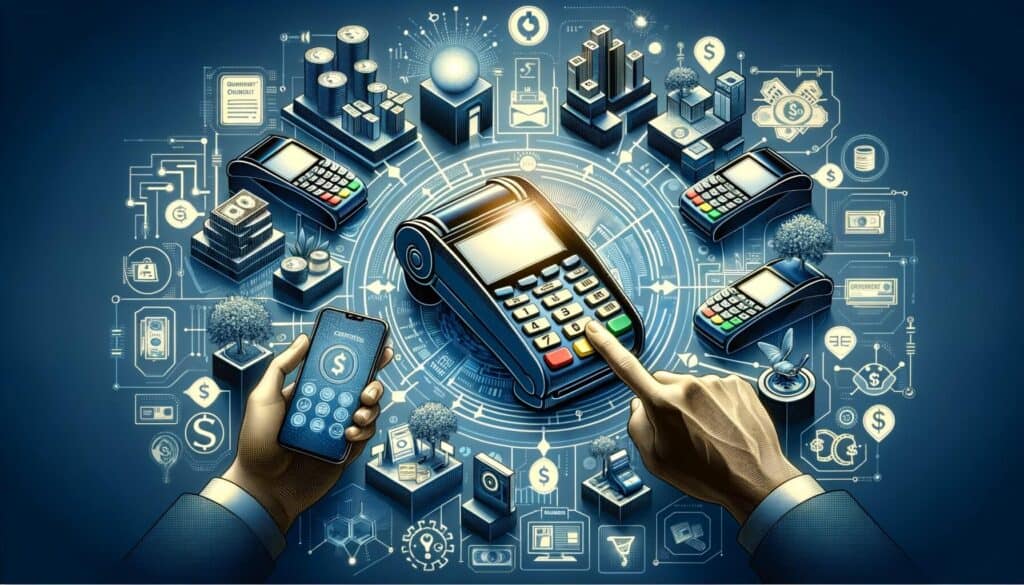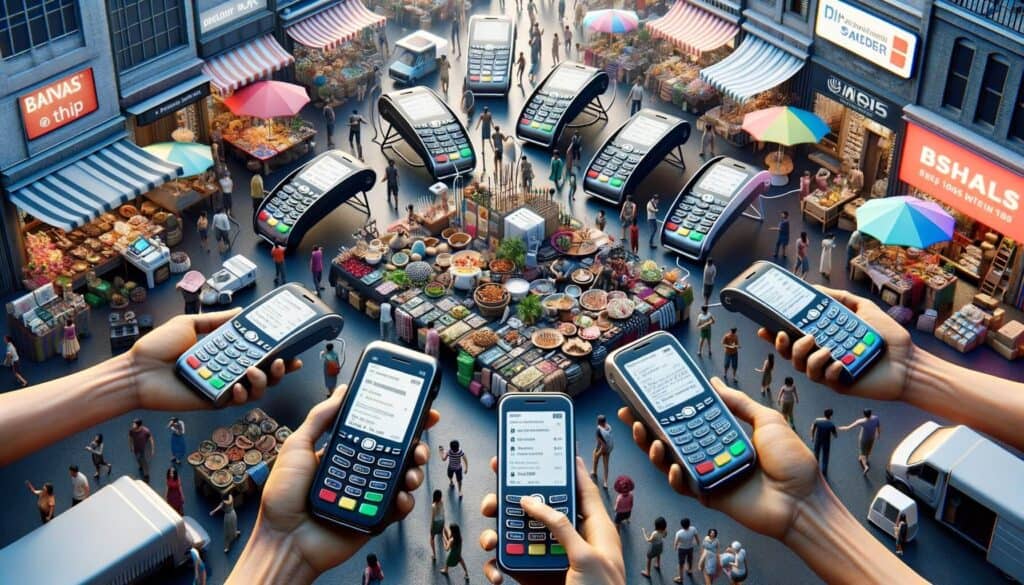
By Amanda Hoglund January 10, 2025
In today’s digital age, cashless transactions have become the norm, and businesses are constantly seeking ways to streamline their payment processes. One such method is through cash discount merchant services programs, which allow merchants to pass on the cost of credit card processing fees to customers who choose to pay with a card.
However, for these programs to be successful, merchants need to have the right terminals in place. Terminals play a crucial role in facilitating transactions and ensuring a seamless payment experience for both merchants and customers. In this article, we will explore the different types of terminals available for cash discount merchant services programs and discuss the factors to consider when choosing the best terminal for your business.
Factors to Consider When Choosing Terminals for a Cash Discount Merchant Services Program

When selecting terminals for a cash discount merchant services program, there are several factors that merchants should consider. These factors include the type of business, the volume of transactions, the cost of the terminal, the compatibility with existing systems, and the level of customer support provided by the terminal provider. Let’s delve deeper into each of these factors to understand their significance.
1. Type of Business: The nature of your business plays a crucial role in determining the type of terminal that would best suit your needs. For example, if you have a brick-and-mortar store, you may require a traditional countertop terminal. On the other hand, if you operate a mobile business or frequently attend trade shows and events, a mobile terminal would be more suitable.
2. Volume of Transactions: The number of transactions your business processes on a daily basis is another important consideration. If you have a high volume of transactions, you would need a terminal that can handle the load efficiently without any disruptions. Conversely, if your business has a low volume of transactions, you may opt for a more basic terminal that meets your requirements without unnecessary features.
3. Cost of the Terminal: The cost of the terminal is a significant factor for most businesses. It is important to consider both the upfront cost of purchasing or leasing the terminal, as well as any ongoing fees or charges associated with its use. It is advisable to compare prices and features of different terminals to find the best value for your business.
4. Compatibility with Existing Systems: If you already have a point-of-sale (POS) system or other payment processing software in place, it is crucial to ensure that the terminal you choose is compatible with your existing systems. This will help avoid any compatibility issues and ensure a smooth integration of the terminal into your business operations.
5. Customer Support: Reliable customer support is essential when it comes to terminals for cash discount merchant services programs. In case of any technical issues or questions, having access to prompt and knowledgeable customer support can save you time and frustration. It is advisable to research the reputation of the terminal provider and read reviews to gauge the level of customer support they offer.
By considering these factors, merchants can make an informed decision when choosing the best terminals for their cash discount merchant services program. Now, let’s explore the different types of terminals available and their pros and cons.
Traditional Terminals: Exploring the Pros and Cons

Traditional terminals, also known as countertop terminals, are the most common type of terminals used in brick-and-mortar stores. These terminals are typically connected to a phone line or internet connection and allow merchants to accept payments through various methods, including credit cards, debit cards, and contactless payments. Let’s examine the pros and cons of traditional terminals.
Pros:
1. Reliability: Traditional terminals are known for their reliability. They have been used for many years and have proven to be a dependable option for processing payments.
2. Security: Traditional terminals are designed with security features to protect sensitive customer data. They often comply with Payment Card Industry Data Security Standard (PCI DSS) requirements, ensuring that transactions are secure.
3. Versatility: Traditional terminals can accept a wide range of payment methods, including magnetic stripe cards, chip cards, and contactless payments. This versatility allows merchants to cater to the preferences of their customers.
4. Ease of Use: Traditional terminals are generally user-friendly and easy to operate. They often come with a keypad and a display screen, making it simple for both merchants and customers to navigate through the payment process.
Cons:
1. Limited Mobility: Traditional terminals are stationary and require a physical connection to a phone line or internet connection. This limits their mobility and makes them less suitable for businesses that operate on-the-go or at multiple locations.
2. Cost: Traditional terminals can be expensive, especially if you opt for advanced models with additional features. Additionally, there may be ongoing fees associated with the use of these terminals, such as monthly service fees or transaction fees.
3. Lack of Flexibility: Traditional terminals may lack the flexibility to adapt to changing payment trends and technologies. As the payment landscape evolves, merchants may need to invest in additional equipment or upgrades to keep up with the latest advancements.
Despite these limitations, traditional terminals continue to be a popular choice for many businesses due to their reliability and security features. However, for businesses that require more flexibility and mobility, mobile terminals may be a better option.
Mobile Terminals: A Convenient Solution for On-the-Go Merchants

Mobile terminals, also known as wireless terminals, are designed for businesses that operate outside of traditional brick-and-mortar stores. These terminals connect to a cellular network or Wi-Fi, allowing merchants to accept payments anywhere, anytime. Let’s explore the pros and cons of mobile terminals.
Pros:
1. Mobility: The primary advantage of mobile terminals is their mobility. They enable businesses to accept payments on-the-go, whether it’s at a customer’s location, a trade show, or an outdoor event. This flexibility is particularly beneficial for businesses that do not have a fixed physical location.
2. Cost-Effective: Mobile terminals are often more cost-effective compared to traditional terminals. They typically have lower upfront costs and may not require additional phone lines or internet connections. This makes them an attractive option for small businesses or startups with limited budgets.
3. Quick and Convenient: Mobile terminals offer a quick and convenient payment experience for both merchants and customers. Transactions can be processed swiftly, and customers can receive instant confirmation of their payment.
4. Integration with POS Systems: Many mobile terminals can integrate with existing point-of-sale (POS) systems or payment processing software, allowing for seamless integration of payment data into business operations.
Cons:
1. Reliance on Cellular Network or Wi-Fi: Mobile terminals rely on a cellular network or Wi-Fi connection to process transactions. In areas with poor network coverage or weak Wi-Fi signals, merchants may experience connectivity issues, leading to delays or failed transactions.
2. Battery Life: Mobile terminals are powered by batteries, which means they have a limited battery life. Merchants need to ensure that the terminal is fully charged or have backup batteries available to avoid any disruptions in payment processing.
3. Limited Functionality: Mobile terminals may have limited functionality compared to traditional terminals. They may not support certain features, such as printing receipts or processing certain types of payments. Merchants should carefully assess their business needs and ensure that the mobile terminal meets their requirements.
Despite these limitations, mobile terminals offer a convenient and flexible solution for businesses that operate on-the-go. They are particularly popular among food trucks, delivery services, and businesses that attend trade shows or events. However, for businesses that primarily operate online, virtual terminals may be a more suitable option.
Virtual Terminals: Streamlining Online Payments for Cash Discount Programs

Virtual terminals, also known as online payment gateways, are designed for businesses that primarily operate online or process payments remotely. These terminals allow merchants to accept payments through their website or over the phone, without the need for physical card readers. Let’s explore the pros and cons of virtual terminals.
Pros:
1. Accessibility: Virtual terminals enable businesses to accept payments from customers anywhere in the world, as long as they have an internet connection. This accessibility expands the customer base and allows businesses to reach a wider audience.
2. Convenience: Virtual terminals offer convenience for both merchants and customers. Customers can make payments from the comfort of their own homes, and merchants can process transactions without the need for physical card readers or terminals.
3. Cost-Effective: Virtual terminals often have lower upfront costs compared to traditional terminals. They typically do not require any physical equipment, such as card readers or printers, which can result in cost savings for businesses.
4. Integration with E-commerce Platforms: Many virtual terminals can integrate seamlessly with popular e-commerce platforms, such as Shopify or WooCommerce. This integration simplifies the payment process for merchants and ensures a smooth customer experience.
Cons:
1. Security Concerns: Virtual terminals may raise security concerns for some merchants and customers. As transactions are processed online, there is a risk of data breaches or unauthorized access to sensitive customer information. Merchants should ensure that their virtual terminal provider has robust security measures in place to protect against such risks.
2. Technical Requirements: Virtual terminals require a stable internet connection and compatible devices to process transactions. Merchants need to ensure that their systems meet the technical requirements of the virtual terminal provider to avoid any compatibility issues.
3. Lack of Physical Presence: Some customers may prefer the reassurance of a physical card reader or terminal when making payments. Virtual terminals may not provide the same level of trust and familiarity as traditional terminals, which could potentially impact customer confidence.
Despite these limitations, virtual terminals offer a streamlined and efficient payment solution for businesses that primarily operate online. They are particularly popular among e-commerce businesses, subscription-based services, and businesses that offer remote services. However, for businesses that require a more integrated solution, integrated terminals may be the way to go.
Integrated Terminals: Enhancing Efficiency and Customer Experience
Integrated terminals, also known as point-of-sale (POS) systems, are comprehensive solutions that combine hardware, software, and payment processing capabilities into a single system. These terminals offer a range of features, including inventory management, sales reporting, and customer relationship management (CRM) tools. Let’s explore the pros and cons of integrated terminals.
Pros:
1. Efficiency: Integrated terminals streamline business operations by consolidating various functions into a single system. Merchants can manage inventory, process payments, and generate reports all from one interface, saving time and reducing the risk of errors.
2. Enhanced Customer Experience: Integrated terminals offer features that can enhance the customer experience, such as loyalty programs, personalized offers, and targeted marketing campaigns. These features help build customer loyalty and increase customer satisfaction.
3. Scalability: Integrated terminals are highly scalable and can accommodate the needs of growing businesses. They often offer additional features and modules that can be added as the business expands, allowing for seamless growth without the need for significant system upgrades.
4. Data Insights: Integrated terminals provide valuable data insights that can help merchants make informed business decisions. Sales reports, customer analytics, and inventory management tools enable merchants to identify trends, optimize operations, and improve profitability.
Cons:
1. Cost: Integrated terminals can be expensive, especially for small businesses or startups with limited budgets. They often require an upfront investment in hardware, software licenses, and ongoing fees for maintenance and support.
2. Complexity: Integrated terminals can be complex to set up and operate, especially for merchants who are not familiar with POS systems. Training may be required to ensure that merchants and staff can effectively utilize all the features and functionalities of the system.
3. Compatibility Issues: Integrated terminals may face compatibility issues with existing systems or software. Merchants need to ensure that the integrated terminal is compatible with their current infrastructure to avoid any disruptions in business operations.
Despite these limitations, integrated terminals offer a comprehensive solution for businesses that require advanced features and functionalities. They are particularly popular among retail stores, restaurants, and businesses that require robust inventory management capabilities. However, for businesses that want to embrace the future of cash discount merchant services, contactless payment terminals are the way forward.
Contactless Payment Terminals: Embracing the Future of Cash Discount Merchant Services
Contactless payment terminals, also known as Near Field Communication (NFC) terminals, enable customers to make payments by simply tapping their contactless-enabled cards or mobile devices on the terminal. These terminals use radio frequency identification (RFID) technology to securely transmit payment information. Let’s explore the pros and cons of contactless payment terminals.
Pros:
1. Speed and Convenience: Contactless payments are incredibly fast and convenient. Customers can make payments by simply tapping their cards or mobile devices on the terminal, eliminating the need to insert or swipe cards. This reduces transaction times and enhances the overall customer experience.
2. Enhanced Security: Contactless payment terminals use advanced encryption technology to protect payment information. The use of tokenization ensures that sensitive card details are not stored on the terminal, reducing the risk of data breaches or fraud.
3. Future-Proof: Contactless payment terminals are future-proof, as they are compatible with emerging payment technologies, such as mobile wallets and wearable devices. By adopting contactless payment terminals, businesses can stay ahead of the curve and cater to the preferences of tech-savvy customers.
4. Hygienic: In light of the COVID-19 pandemic, contactless payments have gained even more popularity due to their hygienic nature. Customers can make payments without physically touching the terminal, reducing the risk of spreading germs.
Cons:
1. Limited Acceptance: While contactless payments are gaining traction, not all customers have contactless-enabled cards or mobile devices. This limited acceptance may restrict the number of customers who can make contactless payments, especially in certain demographics or regions.
2. Cost: Contactless payment terminals may be more expensive compared to traditional terminals. However, as contactless payments become more prevalent, the cost of these terminals is expected to decrease over time.
3. Education and Awareness: Some customers may be unfamiliar with contactless payments or have concerns about their security. Merchants need to educate customers about the benefits and security features of contactless payments to build trust and encourage adoption.
Despite these limitations, contactless payment terminals offer a secure and convenient payment solution that aligns with the evolving preferences of customers. They are particularly popular in industries such as retail, hospitality, and transportation. Now that we have explored the different types of terminals available for cash discount merchant services programs, let’s discuss how to choose the right terminal provider for your business.
Choosing the Right Terminal Provider for Your Cash Discount Program
When selecting a terminal provider for your cash discount program, it is important to consider several factors. These factors include the reputation and reliability of the provider, the range of terminals and features offered, the level of customer support provided, and the pricing structure. Let’s delve deeper into each of these factors to understand their significance.
- Reputation and Reliability: Look for a terminal provider with a solid reputation and a track record of reliability. Read reviews, ask for recommendations, and research the provider’s history to ensure they have a proven track record in the industry.
- Compatibility: Ensure that the terminal provider’s devices and software are compatible with your business’s needs. Consider factors such as the types of payment methods supported, integration with other systems (such as POS or inventory management), and ease of use.
- Customer Support: Good customer support is essential when it comes to terminal providers. Look for a provider that offers 24/7 customer support, multiple channels of communication, and a responsive and knowledgeable support team.
- Pricing and Fees: Compare the pricing and fees of different terminal providers to find the most cost-effective option for your business. Consider factors such as upfront costs, transaction fees, monthly fees, and any additional charges for features or services.
- Security Measures: Ensure that the terminal provider has robust security measures in place to protect sensitive customer data. Look for features such as encryption, tokenization, and fraud detection systems.
- Scalability: Consider your business’s future growth and expansion plans. Choose a terminal provider that can accommodate your business’s evolving needs and can scale with your growth.
Frequently Asked Questions (FAQs)
Q1. What is a cash discount merchant services program?
A cash discount merchant services program is a payment processing model where merchants offer a discount to customers who pay with cash, while passing on the cost of credit card processing fees to customers who choose to pay with a card.
Q2. Can I use my existing terminal for a cash discount program?
In most cases, you can use your existing terminal for a cash discount program. However, you may need to reprogram or update the terminal to ensure it can accurately calculate and apply the cash discount.
Q3. Can I offer multiple payment options in a cash discount program?
Yes, you can offer multiple payment options in a cash discount program. It is important to provide customers with a variety of payment methods to cater to their preferences and enhance their overall experience.
Q4. Are there any legal considerations when implementing a cash discount program?
Yes, there may be legal considerations when implementing a cash discount program. It is important to consult with legal professionals to ensure compliance with local laws and regulations regarding surcharging and cash discounts.
Q5. Can I switch terminal providers if I am not satisfied with my current one?
Yes, you can switch terminal providers if you are not satisfied with your current one. However, it is important to consider any contractual obligations or termination fees before making the switch.
Conclusion
Choosing the right terminals for your cash discount merchant services program is crucial for optimizing your payment processes and enhancing the customer experience. Traditional terminals offer reliability and security but may lack mobility and advanced features. Mobile terminals provide flexibility and convenience but may have limitations in terms of battery life and connectivity. Virtual terminals streamline online payments but require robust security measures and technical expertise.
When selecting a terminal provider, consider factors such as reputation, compatibility, customer support, pricing, security measures, and scalability. By carefully considering these factors and understanding the specific needs of your business, you can select the ideal terminals to optimize your cash discount merchant services program and drive success in the digital payment landscape.